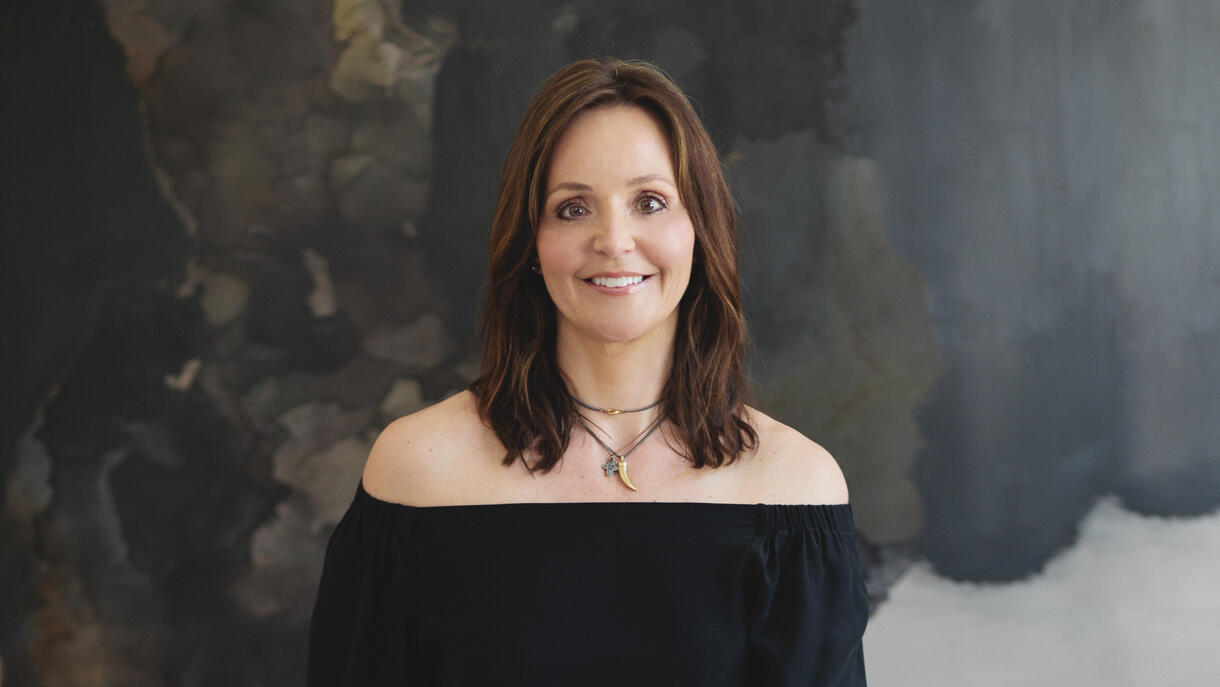
This Alabama designer wants to create, not copy
The 50 States Project is a series of candid conversations with interior designers across the country about how they’ve built their businesses. This week, Birmingham, Alabama–based designer Dana Wolter tells us about the growing Birmingham design scene, why she has a three-room minimum, and why she’ll always choose texture and detail over pattern and color.
You were originally slated to kick off this series last year, but then you had a life-changing medical diagnosis. Can you share what happened?
I found out on December 23, 2021, that I had a tumor on my spine. We didn’t know what it was, but we knew it was bad. I found out on January 4, 2022, that I had Non-Hodgkin lymphoma, stage four. I found out that morning, and they started chemo that night.
That sounds so scary—and so sudden. You’ve been documenting your medical journey on Instagram for the past year. It seems like you’re doing well?
I was at MD Anderson [Cancer Center] right before Christmas, and everything looks good.
Congratulations!
Thank you. I’m very grateful for that. You know, you just never think it’ll happen to you—especially when you’re healthy, and you think you’re doing the right things. It was definitely a curveball, and a big one.
Cancer is not uncommon once you start talking about it—I know that from personal experience—but it’s crazy how rarely people talk about it.
It’s like one out of three women will face cancer, and one out of two men. I mean, the statistics are really high. I think that’s one of the reasons I’ve tried to be so vocal on social media. One, I wanted to control the narrative. I live in a beautiful community, but it’s small, and I wanted to make sure that the correct information was out there. And hopefully, I’ve been able to help some people along the way. I’ve had a lot of people help me too—even just to say it’s gonna be OK, you know? None of us are guaranteed tomorrow, but I’m really not guaranteed tomorrow. So it means a lot to hear somebody say, “Hey, I had this 15 or 20 years ago, and I’m doing great. You can do this.” I’m so glad I’ve shared it, and that I made the decision to be so open because it’s been a beautiful thing in so many ways.
How did this experience reshape the way you looked at your business?
My life was turned upside down. And it had happened so fast that there was no preparation. The whole process made me reevaluate a lot of things: What is important to me? Where do I want my life to go? I’m more focused now on who I want to be as a person versus what I want to accomplish. That was a really big transition for me after this journey.
My business is broken up into two different parts—an operations side and an interior design side, and each is very distinct with distinct roles. The operations side can run on its own in my sleep. But at the time, my hands were in too many of the weeds on the design side. I realized when I was sick that I had to get my hands out of the everyday things. We have really worked hard over the past six to eight months to get the right people in the right positions.
How did that evolve?
The highest-level person on my design team was part-time. She had been with me for a long time, but I realized that needed to be a full-time position. We’ve since made it a full-time position with someone else, and it’s completely transformed the way my office runs on that side. My hands are no longer in the weeds. That’s not to say we don’t have issues come up that I have to be involved in, but I’m not having to do the little things that I have no business doing. I feel like people are responsible for their jobs, and that they treat their jobs more as a passion and a career versus just a job.
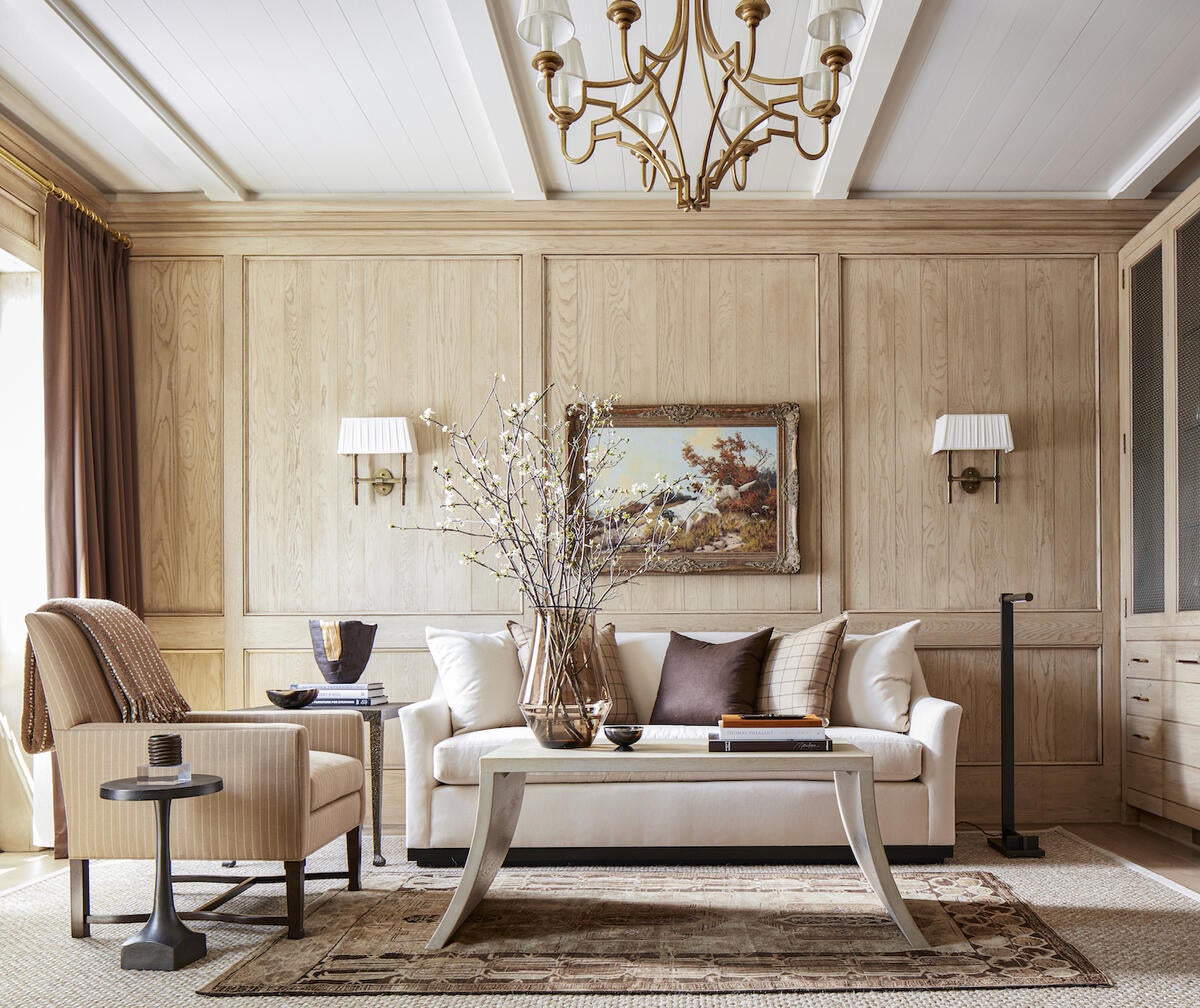
Warm wood paneling is an inviting backdrop for a living space that balances comfort and refinementJohn Bessler
How do you help your team feel invested in the purpose of the firm?
I think that comes from our core ideology and goals. For instance, our core ideology is “do the right thing”—even if it’s not advantageous to us, you do the right thing. And that really drives a lot of what goes on in our business.
One of the other things I’ve realized is that you have to hire people who are motivated. You can’t motivate people to want to do a job. They have to want to be there. Sometimes, it’s about making sure the right person is in the right position. You might have the right person, but they might be in the wrong position. And sometimes you just don’t have the right hires. I mean, that’s happened to all of us. But I feel very confident about my team right now, and I’m excited about where we’re going. We’re making some really lofty goals.
I love seeing personal growth too—that’s important to me. I want anyone who works in the office to continue to grow, and I want to be able to help them in any way I can. I want them to feel like they’re a better person and they have more skills from working at DWI than they would if they didn’t.
How many people are on the team total? What are each of their roles?
There are seven of us and we’re looking to add a junior designer, which will make eight. But I’m taking my time on the hire—I want to make sure we hire the right person.
So there’s me, the principal. And then there is Kimberly, the office manager, who oversees the operations side of the business while I oversee the interior design side. And under Kimberly, there’s a procurement manager. And then we have Alex, who’s my lead designer. And then I have Claire, who is my bookkeeper. And then I have Rebecca, who helps me with my social media marketing. And then we have an intern, and we’re looking to hire another junior designer under Alex.
As you were formalizing that structure and those roles, what did you realize that you wanted to hold on to for yourself?
I didn’t want my hands in any of the operations. Once the interior design side has curated a room or home, we turn it over to our operations team to enter it and create our mood boards. They know what the markup is. I let them do their job.
My hands are still into the interior design side, especially the overall vision of the home’s rooms. Alex is very talented and he does a great job with the drawings and elevations, but at the end of the day, I’m redlining them and giving my OK. Some days, I’m jumping in and pulling the fabrics for a room, but the goal is for me to give the overall creative vision, let the team do the work, and then they present it to me and we tweak it from there.
Where does the client see you, and where do they interact with your team?
It’s definitely a collaborative effort. I always know what’s going on with projects, and I’m not gonna give that up—my office does a good job of copying me on emails and keeping me abreast. But I trust my team to answer client questions, and if they aren’t sure how to answer, there’s communication between us, or I will jump in and help the team.
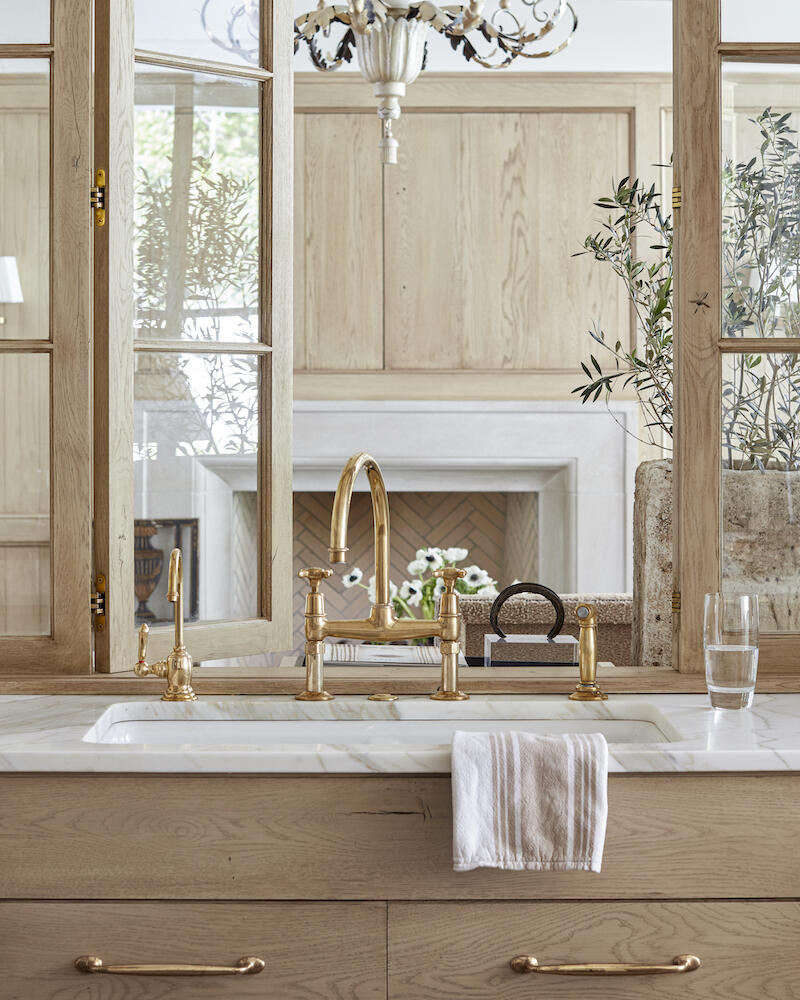
A glass pass-through window between the kitchen and dining room allows the homeowners to opt for privacy or combine the two spacesJohn Bessler
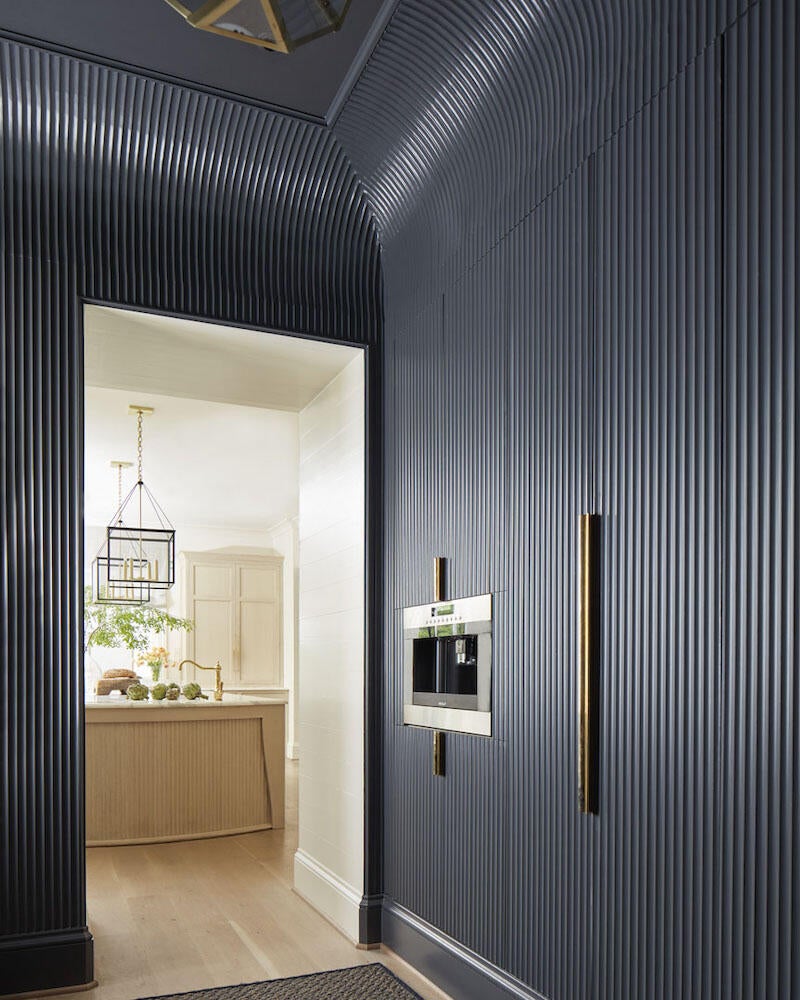
Plaster fluting echos the cabinetry, curving elegantly to meet the ceilingJohn Bessler
Left: A glass pass-through window between the kitchen and dining room allows the homeowners to opt for privacy or combine the two spaces John Bessler | Right: Plaster fluting echos the cabinetry, curving elegantly to meet the ceiling John Bessler
Did you always want to be a designer? When did you start to pursue this as a career?
I’ve been doing this a long time—it’ll be 18 years in April—but it was a windy road to get here.. I took some interior design classes when in college, but I changed my major three times. I had no idea what I wanted to do with my life. I graduated with a major in English and journalism. I went into sales after college, but the passion [for design] was always there. I always say to find things that come naturally to you that you enjoy. Passions may ebb and flow, but I think they’re always there.
After I had my second child, I stayed home, and my husband and I fixed a couple of houses and sold them. They sold well, and fast, and we had friends along the way who would say, “Will you help me with this?” Back in 2005, I had two friends approach me at the same time—they both said, “Look, I want to pay you to help me with my home.” I started my business that way. Then the referrals came, and in time, my business has grown to where it is.
How many projects is a full plate for you right now?
We vary from seven to 12, all of them at different stages. We try to be discerning as far as what we take on. Lately, we’ve been doing a lot of out-of-state projects. It used to be that we would have most of our work in Birmingham and around Alabama, but [then it shifted to other locations and] we didn’t have much going in Alabama until two or three months ago. And now we have two in Birmingham.
What gets you excited to say yes to a project right now?
I love that question. Right now, it’s when there are really detailed plans, with beautiful finishes, and where the client appreciates beautiful finishes and wants a truly custom home that is tailored to them and their family. That’s what really excites me—that they’re open to let us be creative.
For instance, we’ve had four houses in the past year over in Alys Beach and [on Scenic Highway] 30A. We’re working on one now for a Midwestern couple that will eventually be their forever home, and they are so open to our ideas, which has allowed me and my team to really say, “OK, what can we create for this family that’s beautiful and unique, makes it livable and a wonderful home that functions well for their family?” And that gets me excited.
Is there a way to tell that a client is going to be receptive in that way?
It’s hard. Sometimes we get it right, sometimes we don’t. Sometimes, questions about who they’ve hired for their team and their budget will help you see what kind of house they’re pursuing. In a way, the project is my baby as much as it is theirs, you know? I joke that a lot of times we know the house better than the client does because we know every nook and cranny, we can tell you the dimensions, and we want it to be as good of an end result as they do.
How much of your work is a primary home versus a secondary home? And does that change your approach at all?
We’ve been doing a lot of vacation homes since COVID, and I love doing vacation homes. It seems like the client may be a little bit more laid-back. We can do the whole shebang, where it truly is turnkey—everything from the potty brush in the bathroom to the dishes and cutlery in the kitchen cabinets, all in its place. We have done that a few times, and we have it down to a science, you know, where we know how to keep it running smoothly and keep it going.
Is a full-service project—the plates-in-the-cupboards kind—more fulfilling?
Yes, that is my favorite type of project, where the client walks in with a suitcase and just unpacks their clothes. And we’ve done several of that kind. For instance, we had a wonderful client in northern Alabama, and their house had burned down and very, very little had been saved. We did everything, and it’s just so fun to see. We’ve given them a beautiful surrounding to make new memories with their family. How much more of a reward can I ask for than that? What a blessing to me and my team just to see how happy they are after they lost everything, and to get emails that say, “This is more than I ever thought it could be. Thank you so much.”
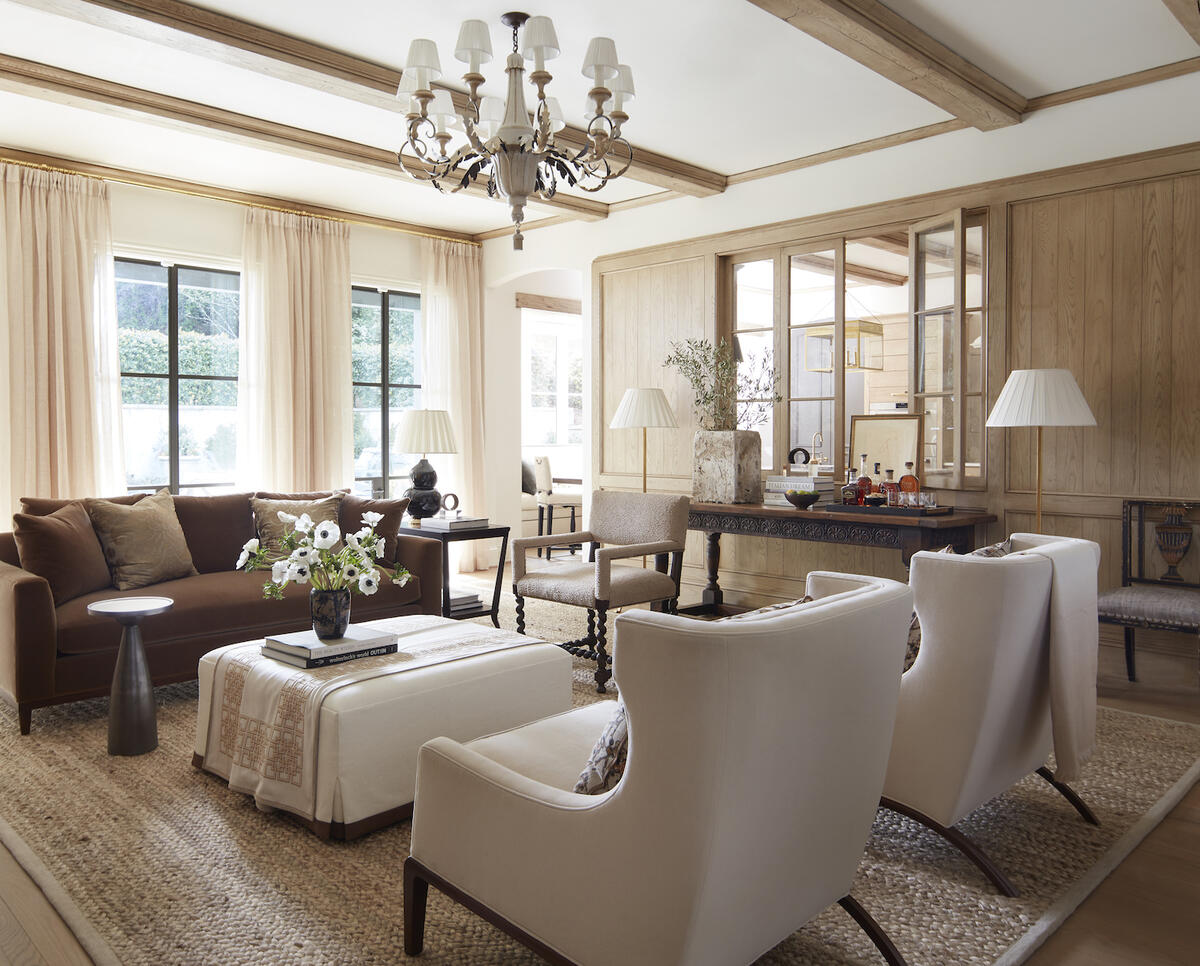
Wolter embraces layered, neutral schemes. ‘I like the yin and the yang of glass and metal against a waxed wood, or a linen against a leather, with a velvet thrown in,’ she says. ‘I love how different textures balance out and play against one another.’John Bessler
There’s such a lively, thriving design scene in Birmingham. Can you tell me about the design community there?
There’s so much talent in Alabama, particularly in Birmingham, and it’s a well-kept secret that I think people are starting to figure out, and it makes me so happy. You know, I had gone to a dinner with some architects and a couple of designers, and one of the men who was there from Philadelphia asked me, “Where do you shop for clothes?” Well, we have great shopping. I think it’s the best place to shop in the Southeast. But it’s a different type of shopping. Yes, we have Saks and we have department stores, but it’s really more just wonderful boutiques. I think you’re going to hear more and more about Birmingham. It’s a foodie town—a lot of James Beard winners here—and it’s growing. I think it’ll be fun to watch Birmingham over the next 10 years and to see where it goes.
What design resources are available, and how do you shop for your clients?
We are constantly looking for sources that everyone else doesn’t know about. We do full-service interior design, so we won’t just come in and pick paint colors for you. We have a three-room minimum to hire us if we end up working together. We have our manufacturers that we love for upholstery, like Hickory Chair and Century and A. Rudin. I love the customization that I can do with Hickory Chair. I like to customize whenever I can and get into any kind of detail. We do a lot of custom pieces—upholstered walls and upholstered screens, and we rarely use a manufacturer fabric. We’re always doing COM fabric on our upholstery. To me, it’s one more chance to fine-tune the fabric with the paint and the other finishes in the room. You can create a pretty room in 10 different ways, but we’re also [considering usage and wear and tear]. So we look at design from not only an aesthetic standpoint, but from a functional standpoint too.
I’m also constantly looking for art in the home. Rarely do we find a piece that we’ll just buy for the home—usually all of our art is commissioned. And we might do 75, 100 pieces of art in a house. It’s easier with some budgets than others.
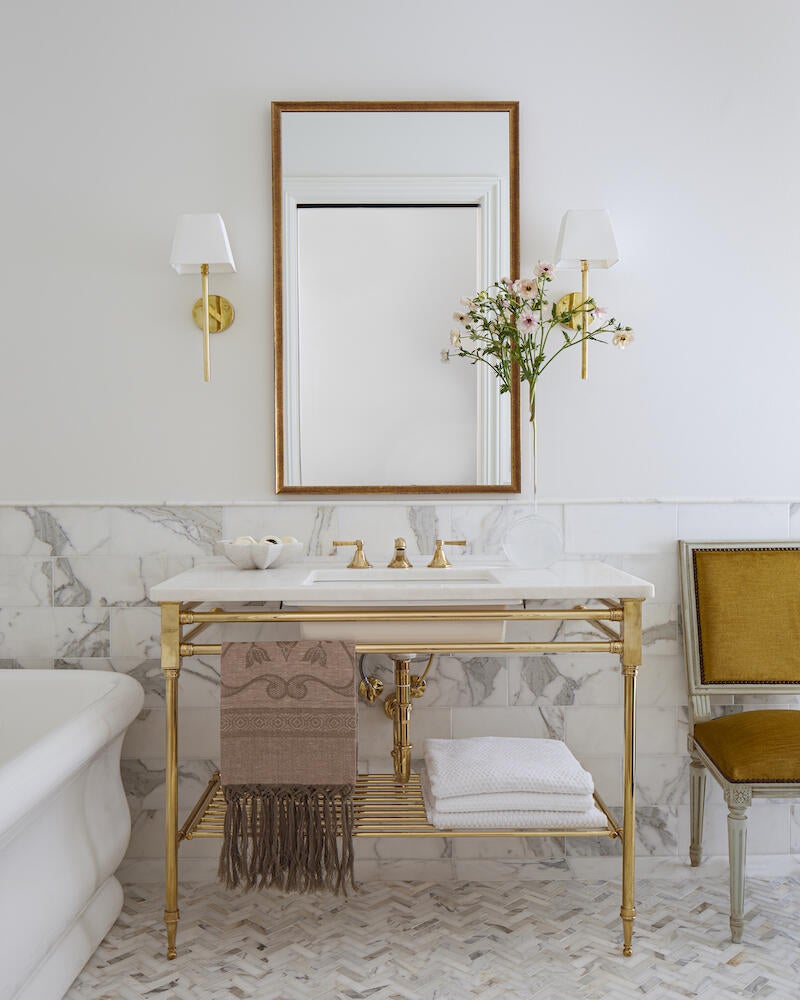
An elegant brass-trimmed bathJohn Bessler
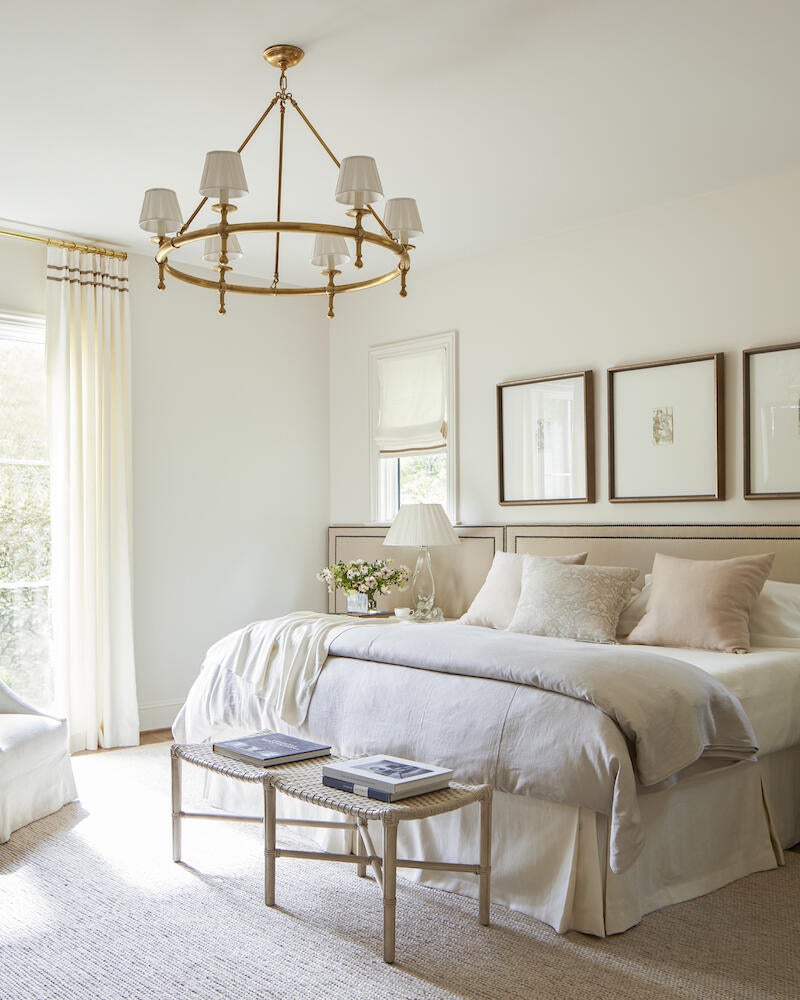
Creamy textiles envelop a dreamy guest suiteJohn Bessler
Left: An elegant brass-trimmed bath John Bessler | Right: Creamy textiles envelop a dreamy guest suite John Bessler
The Southeast has such a strong regional design style. How does that aesthetic impact your work?
I don’t look at that at all. I want to be leading what people are doing versus trying to follow. I’m looking at design more from an investment standpoint—it can be seven figures, you know—and I’m looking at how I can create a home that is beautiful, functional, livable, timeless, unique and not so trendy that it’s going to be dated in a few years. And how can this house grow with their family? That’s what I’m looking at.
And I’m drawn to what I’m drawn to. Even as a child, I hated wearing dresses—my mother and I would get into fights because I would not put a dress on as a 5- or 6-year-old. I’m not a very frilly person. I’m drawn to texture and layers, and I’m very practical. I’m one of five children, and our firm is really good at finding a function for a room and a way for our clients to use that space. I think that comes from being from a large family and being so practical. I’m not drawn to putting a big floral pattern on a chair. I don’t wear floral in my wardrobe. My wardrobe is very neutral. I like great cuts and details, but I don’t like big patterns or bright colors. I’m not saying I won’t use a color here and there if the client likes it, but that’s not what I’m drawn to personally. I like layers. I like the yin and the yang of glass and metal against a waxed wood, or a linen against a leather, with a velvet thrown in. I love how different textures balance out and play against one another.
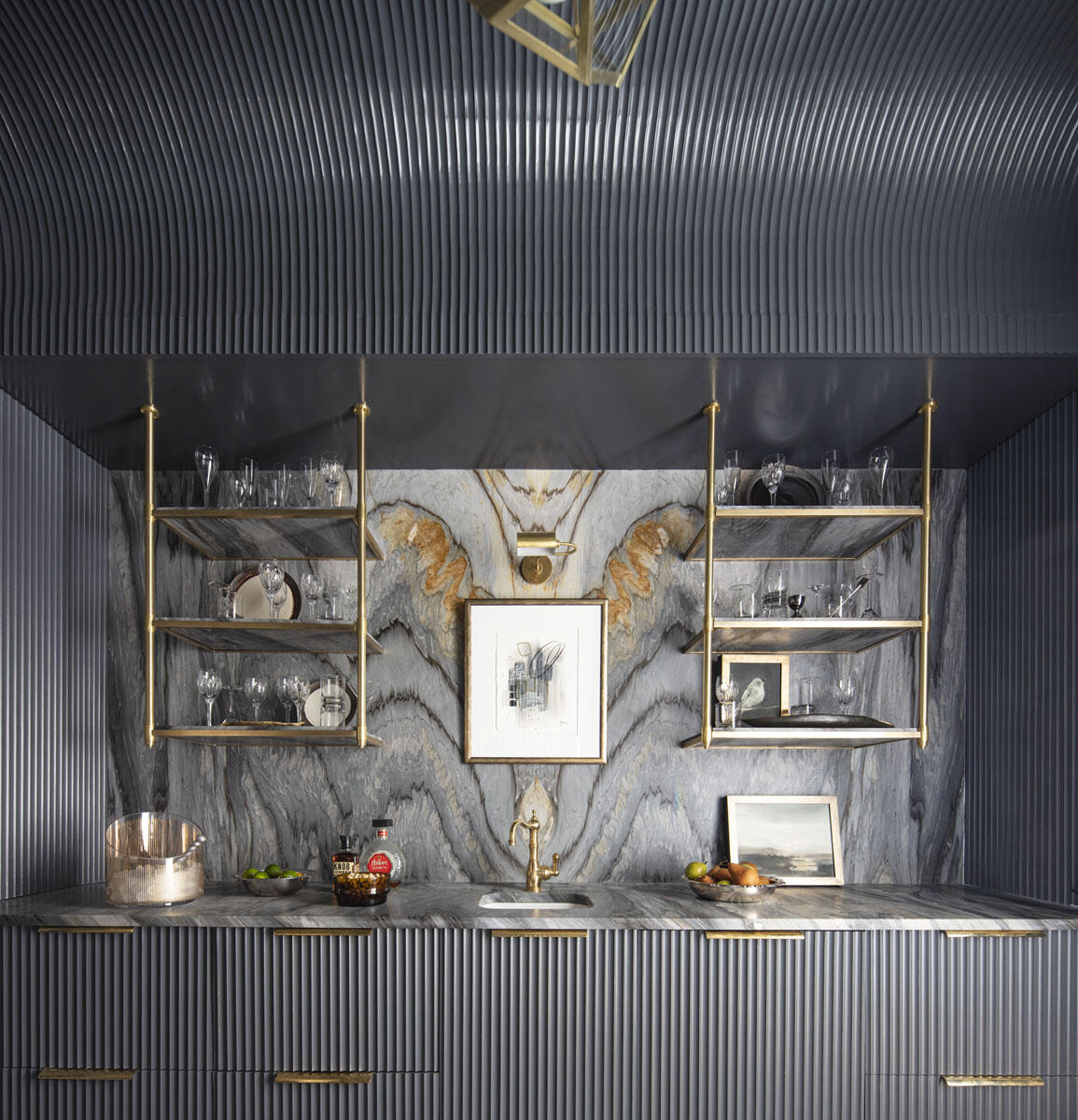
Wolter transformed a hallway into a high-impact sculleryJohn Bessler
How have you approached billing for your work?
We bill a flat fee based on project size and scope. And then we have markup on our product. And we do procurement as an hourly rate.
I love that breakdown. When did you land on that as sort of the most effective choice?
I’ve been doing a flat fee and a cost-plus [model] for many, many, many years. And then after COVID, we’ve had to add in an hourly procurement rate because we were spending so much time dealing with damages and back orders and having to replace things that it was greatly affecting our bottom line.
Have clients been receptive to that?
I think they understand. We are very transparent as far as how we bill and what we bill for. Our operation side of the office just turns it out according to the contract. At the end of the day, I’m not trying to take advantage of anybody, but I have to be profitable.
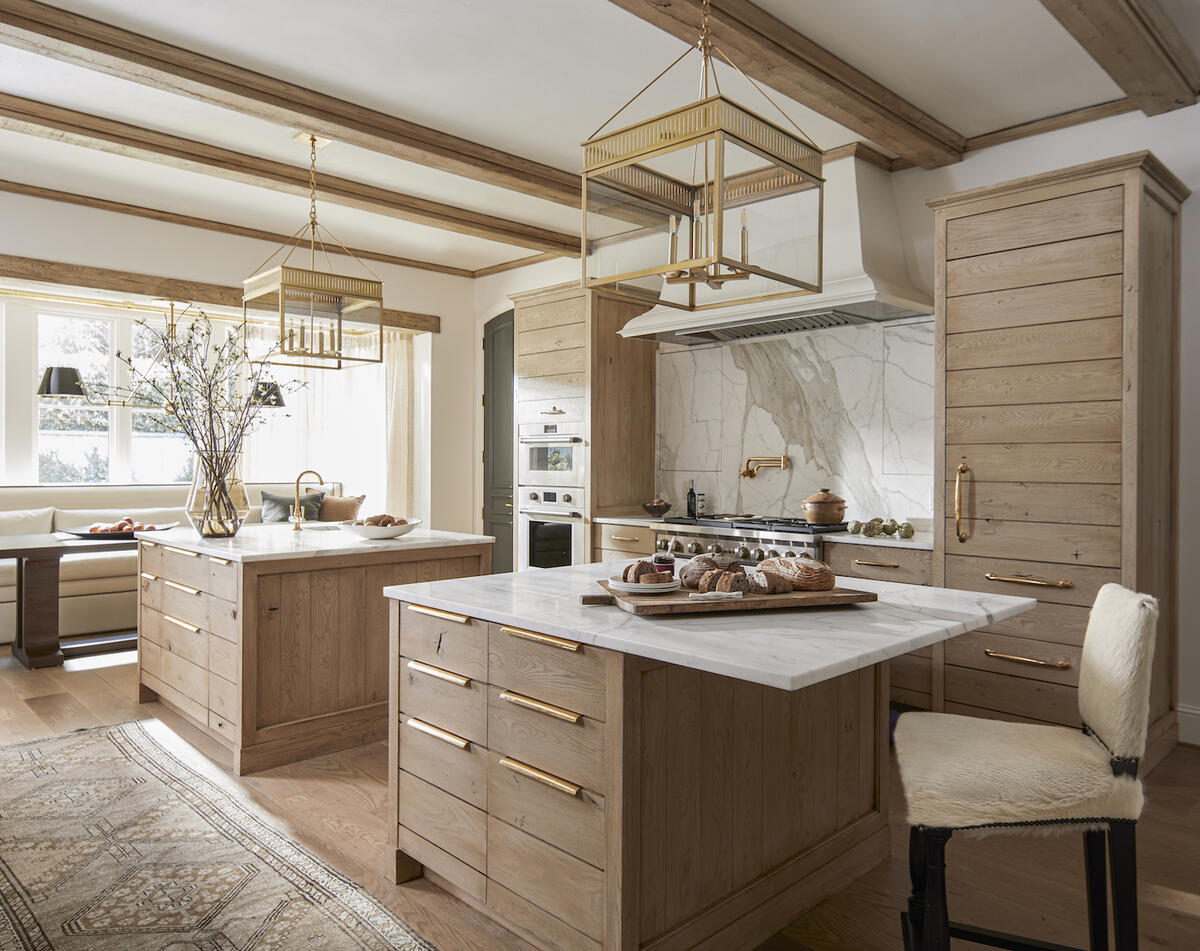
A pair of islands flank the range in a statement-making kitchen clad in warm neutralsJohn Bessler
When you look back, what do you know now that you wish you had known when you started your business?
That it will be OK, Kaitlin. Seriously. Even if something happens, or something gets messed up—at the end of the day, it’ll be OK.
When you look at the design industry at large, what do you see as the industry’s biggest challenge?
Mass production. I’m tired of seeing the same stuff over and over. I want to see unique things that are beautiful and a little different. I have made a conscious effort over the past four months not to be on social media as much because you start seeing stuff over and over, and I really want our office to come out with unique things. I don’t want to copy someone—I want to create something.
What is the part about being the principal of a firm that you feel like we don’t talk about enough?
That it’s hard. I feel like sometimes I have to be people’s cheerleaders, but there’s no one to be mine. I’ve got to sit there and say, “You can do this. You’ve got this. You’re doing a great job at it. Keep going, doing what you’re doing.” And I don’t always have somebody doing that for me. Yes, I have my family, and my family is beautiful, but they’re not going, “Good job at work today, Dana.”
When I was sick, the biggest challenge was just making sure that things were running like they’re supposed to be running. For instance, we had a client who had bought a 10,000-square-foot beach house compound, and they wanted it decorated so they could move in pretty quickly. This was our fourth time working with them, and we pulled together 10,000 square feet of everything for the entire home and presented it just before Christmas, and everything was great. We tabled it because of the holiday, and then I got sick. We made the changes they wanted—and then they decided not to make it their family beach house after all, and to instead keep it on the rental market. That was a seven-figure project that I was counting on for my business. Here I am in the hospital four times in a month, and I just had this horrible thing hit my bottom line—and at the end of the day, I’m responsible. I’m responsible for putting food on the table for my employees to eat. That’s hard. That’s a lot of responsibility.
How do you create the support system you need?
I’ve been doing this almost 18 years, so you get to know people over time. For instance, when I was named the New Trad for Traditional Home back in 2014, two of the ladies that I was named with are still my good friends. I talk with one of them every few months, and she’ll call me if she has an issue: “What would you do?” And I’ll call her if I have an issue. I’m in a small forum through the Design Leadership Network, and that’s proving to be a wonderful community—including some from the manufacturer side, some landscape architects. So just, you know, helping one another—if one of our struggles helps one person, then I’m happy to share [the experience].
What does success look like for you?
Being happy, healthy and building beautiful things that transform people’s lives, while the people in my office [become] better people because they’ve been part of it. It’s not about the money—I want to really help people. I want to change the way people live and be healthy and happy and content while I’m doing it.
To learn more about Dana Wolter, visit her website or find her on Instagram.
